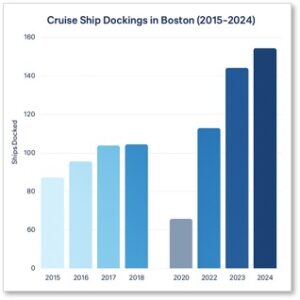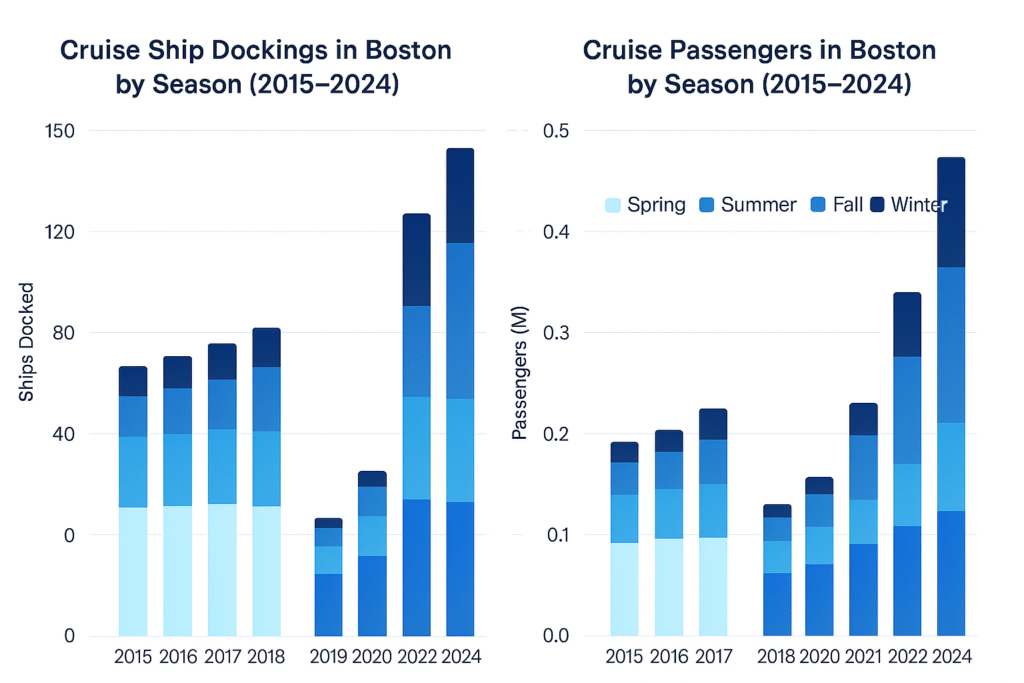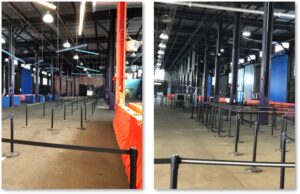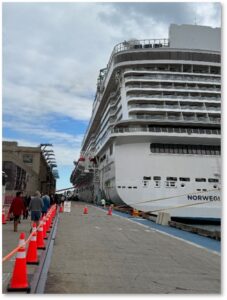 As more cruise ships dock in Boston each year and the number of passengers they carry goes up, I notice how well the city welcomes them. Or not. This includes observations about the Flynn Cruiseport’s physical plant as well as interactions with passengers and watching how they move around.
As more cruise ships dock in Boston each year and the number of passengers they carry goes up, I notice how well the city welcomes them. Or not. This includes observations about the Flynn Cruiseport’s physical plant as well as interactions with passengers and watching how they move around.
As the chart shows, 2015–2019: Passenger counts grew modestly, from ~0.2M to ~0.3M, tracking with ship increases. In 2020 there was a sharp collapse to ~0.1M due to pandemic shutdowns.
From 2021–2022 a recovery resumed, but not all ships operated at full capacity. And from 2023–2024 passenger volume surged, hitting ~0.5M in 2024—a 150% increase over 2015. As I showed in the previous post, they now bring $250,000 in revenue to Boston. So, how do we welcome them to the city?
What the Cruiseport Offers Visitors
To set the picture, here is what the Cruiseport offers passengers today at its two indoor gates when they come to Boston:
- A roof to keep off the rain.
- Bathrooms: Sometimes there is soap but more often not.
- Vending machines: drinks and snacks.
- Folding chairs.
That’s it. A few posters on the walls break up the industrial vibe. In essence, however, it’s a warehouse that’s cavernous, mostly empty, cold in spring and fall. Welcome to Boston.
In the Open Space
At the third gate, called Open Space, passengers don’t even get that much comfort and protection. Instead, they walk up to a half mile, sometimes in the rain or the hot sun, to reach the tour buses for onshore excursions. Unless, that is, the buses have been directed to back up along the pier with the water of the Reserved Channel about six inches away.
If passengers have to wait for a tour to start, they sweat in the sun or get soaked in the rain—while standing up the whole time. Not so much as an awning shelters them from sun and rain. Nor do benches offer respite for the many passengers who are disabled, old, or just plain tired.
Related Post: Raining at the Flynn Cruiseport
The Cruise Ship Irony
Here’s the irony: Open Space is where the smaller, luxury ships often dock when bigger vessels take up Gate 1 and Gate 2. That means the passengers with the most money to spend, and who are most accustomed to the best a city has to offer, get the worst treatment from Boston. Does this make sense to anyone?
When I’m waiting for a tour wearing a lanyard with a Transportation Workers Identity Card (TWIC), I’m often mistaken for a Massport employee. They ask me questions as they emerge disoriented and confused. Often, they are peering at printed maps of the city. When I ask them what they are looking for, they inevitably answer: “Where are we?
Questions Passengers Ask
The questions I hear most, along with the answers, are:
-
How do I get into the city?
Passengers have several options. (1) They can walk; it’s about two miles to the New England Aquarium. (2) They can take shuttle buses IF their cruise line paid for them. (3) A third option is to use a ride share such as Lyft or Uber, although passengers have no idea where to tell the driver to pick them up. (4) And they can use the Silver Line on the T, although most have no idea what it is, where to wait for it, or how to change at South Station. Massport provides no guidance or direction except for those printed maps of the city.
Revenue Opportunity: See below.
-
Where are the shuttle buses?
If the cruise ship has paid for shuttle buses, they come and go at the western end of the Cruiseport, out in the open. Not every cruise line does this, however. If there are no shuttle buses and passengers are not taking a tour, they are on their own. See #1 above.
Revenue Opportunity: Massport could run shuttle buses on a regular basis whenever a ship (or ships) is in port. Even if they only charged $5 per person, a full bus would bring in $260.
-
Where do I tell my Uber/Lyft ride share to pick me up?
This can be touchy. Passengers don’t know where they are or what directions to give the driver. They don’t know if there’s a designated ride-share pickup location. The Dunkin on Drydock Ave. has a sign at the curb that says no pickups here. The Innovation Design Building doesn’t want them in their parking lot, either. And if they pull up to the curb at the Cruiseport, they are likely to be in the way of the tour buses and the taxi stand. That’s dangerous.
Revenue Opportunity: Massport can at least put up a sign at a designated ride-share pickup/dropoff point to avoid confusion and dangerous situations.
-
Where can I park?
This question usually comes from someone waiting to pick up a passenger during a “debark,” which is when passengers are leaving the ship. A parking garage on Drydock Avenue, offers paid parking. Their other choice is Massport’s Cell Phone Waiting Lot on Fid Kennedy Avenue, which is free but difficult to find. They might stop listening to directions when you say, “Turn left where it says Do Not Enter.”
-
Is there drug store nearby?
For part of the day, passengers may find what they need at a little shop in the Cruiseport called the Seafarers Shop. It carries a wide variety of merchandise at reasonable prices, which includes some shelves of drugstore items. So, if all they need is an aspirin, a bandage or some Pepto Bismol, they can probably get it there. If what they require is more specialized, they would need to take a taxi to the nearest CVS or Walgreen’s. And the little shop closes at 3:00 p.m.
Plus, the Seafarers Shop is set up to serve ship and pier workers only. They discourage sending passengers in.
-
Can I get coffee somewhere?
The Dunkin on Drydock Avenue in easy walking distance will do the trick on weekdays. But it’s not open on most Saturdays unless ships are unloading/loading. They are closed every Sunday. If Dunkin isn’t open, their best bet is to walk to a hotel with a coffee shop.
-
Where can I shop?
Where, indeed? The only places where they can buy Boston tee shirts, hats, sweatshirts, fridge magnets, etc. are located in the city nearly two miles away. Often, visitors are looking to buy something at the last minute, but they are out of luck at the Cruiseport.
 Revenue Opportunity: Build out the Cruiseport so it holds shops selling Boston merch and souvenirs, a Dunkin franchise, toiletries, etc. Vendors would pay to rent the space. These shops would remain open until at least 5:00 pm or the last ship’s All Aboard time, whichever comes first.
Revenue Opportunity: Build out the Cruiseport so it holds shops selling Boston merch and souvenirs, a Dunkin franchise, toiletries, etc. Vendors would pay to rent the space. These shops would remain open until at least 5:00 pm or the last ship’s All Aboard time, whichever comes first.
And this is just the passengers. Many people work on the pier, including the tour supervisors, tour guides, bus drivers, cabbies, and State Troopers. While there are places to eat on the north side of the Innovation Design Building, they close at 3:00 pm, and they’re not open on weekends. It’s one thing to grab lunch nearby and another to have to drive to a restaurant to pick up food for your crew. A coffee franchise would also draw business from the workers on the pier, who currently have few options after 3:00 pm, especially on the weekends.
Revenue Opportunity: Rent a few spaces at the pier to food trucks so they can provide lunch and snacks to the workers and State Police officers.
Another Cruiseport Improvement
Another badly needed improvement involves the sidewalks outside the Cruiseport. Many of the passengers on big ships have mobility impairments. These range from a cane to a wheelchair. We also see electric scooters and rollators, not to mention casts and walking boots. These folks take cruises because they can move easily around the big ships. When they reach the sidewalk, however, things change.
First, it is tilted, angling down toward the street. The provides a challenge for old people who have uncertain balance and may be unsteady on their feet. Second, the concrete is cracked and broken, offering many opportunities to trip and fall. It needs work, including leveling and smoothing out the surface.
I’m careful how I walk on it, preferring to stand in the street and avoid the sidewalk’s opportunities for tripping.
Revenue Opportunity: Preventing a lawsuit before it happens.
Come On Down to the Cruiseport
This isn’t difficult, folks, or it shouldn’t be. The perspective from an office on Harborside Drive in East Boston is limited. It won’t show you either the problems or the opportunities. Those of who work on the pier would be happy to point out the problems and how to improve things, though. Really. We’re accustomed to answering questions.



